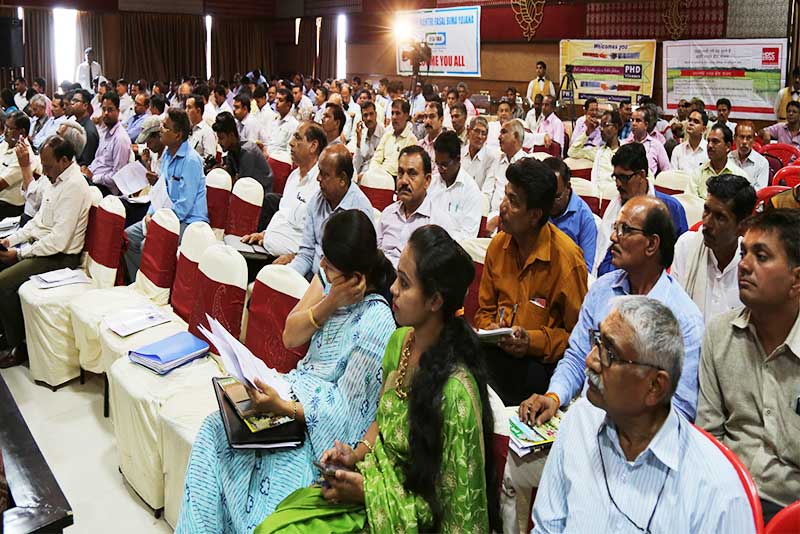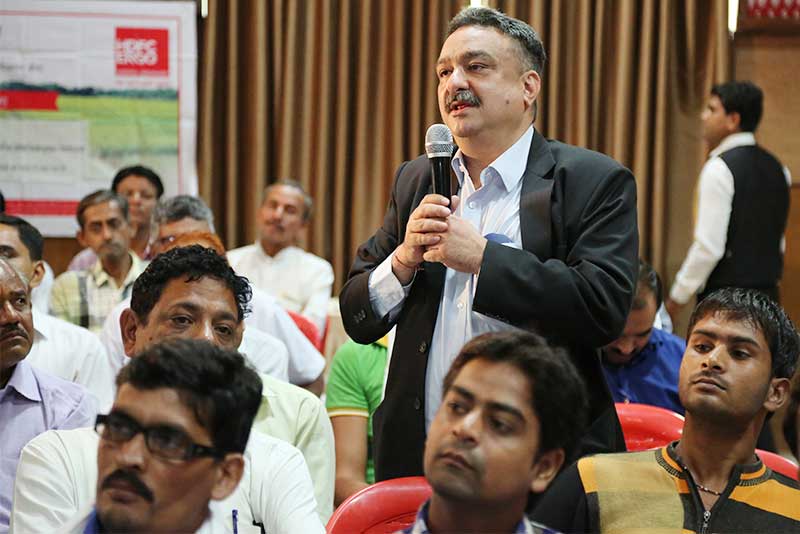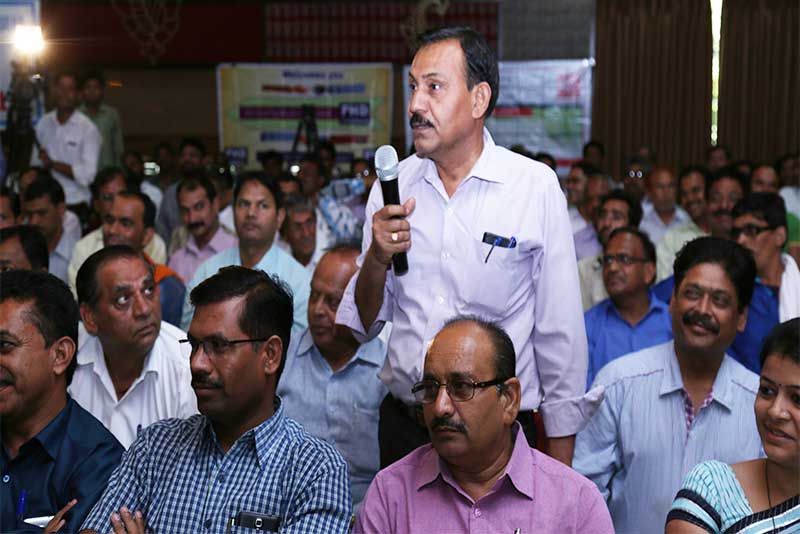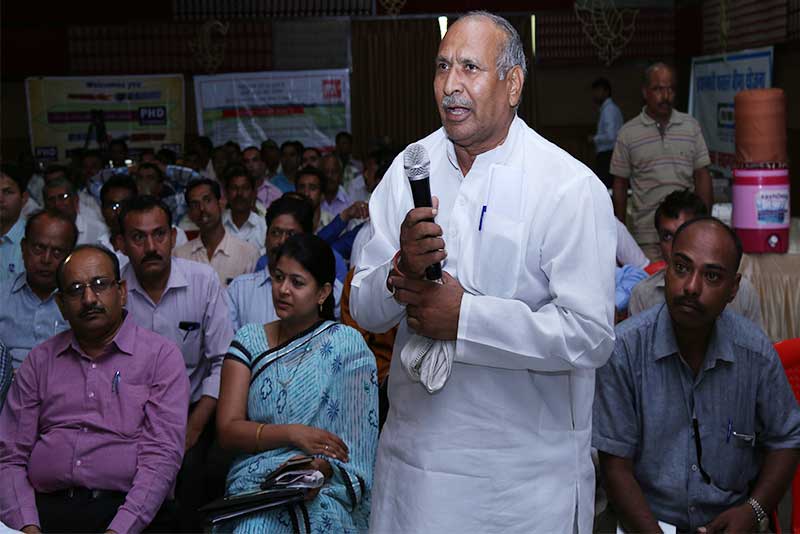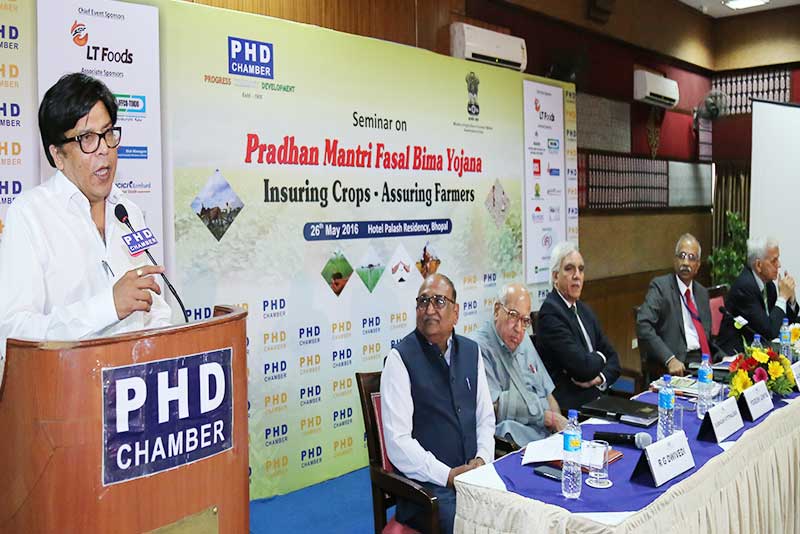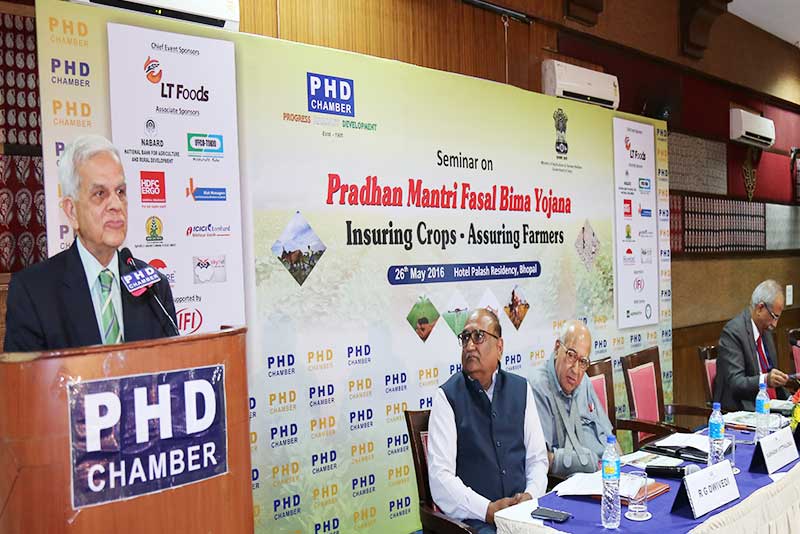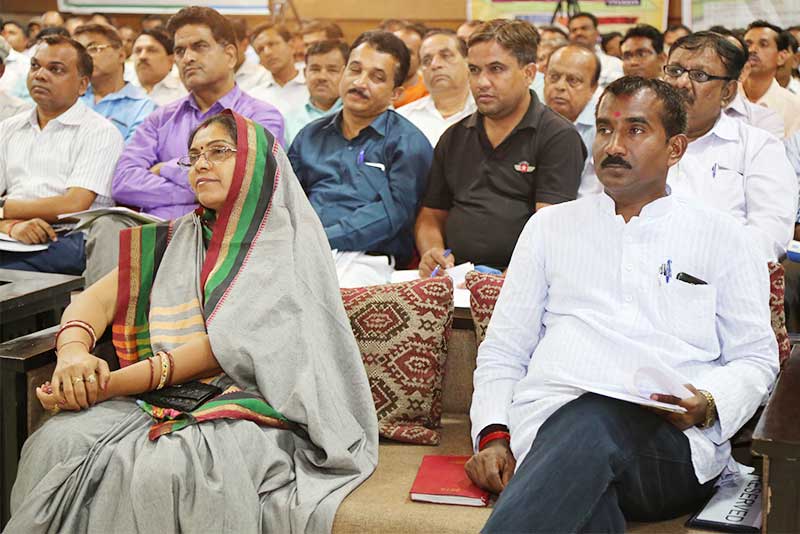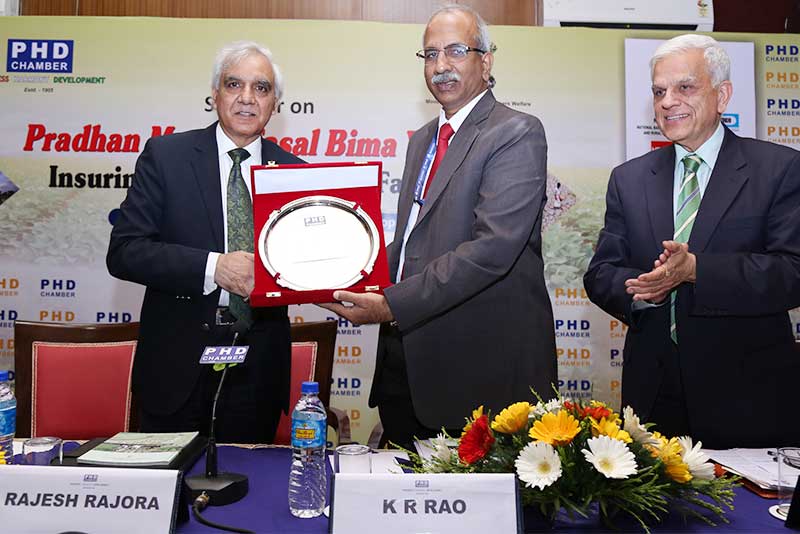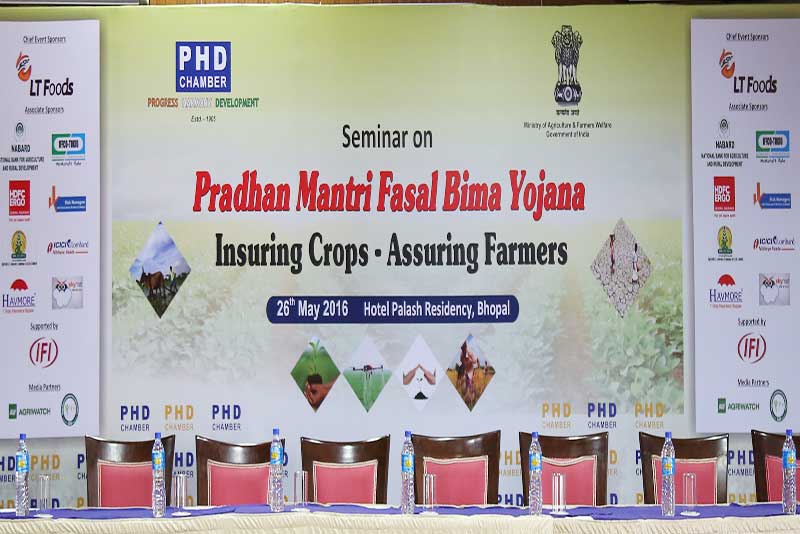National Seminar on Pradhan Mantri Fasal Bima Yojna (Status and Need for Accessibility)
Agriculture has been a crucial sector in many developing countries across the world for its perceived ability to contribute significantly to achieve developmental objectives such as economic growth, employment generation, food security, poverty reduction, and environmental sustainability. Increasing the productive capacity of agriculture through higher productivity has been the main policy agenda in many developing economies.
Madhya Pradesh is located in Central India. The state is bound on the north by Uttar Pradesh, the east by Chhattisgarh, the south by Maharashtra and the west by Gujarat and Rajasthan. It is among the fastest growing states in the country. Madhya Pradesh is rich in natural resources – fuels, minerals, agriculture and biodiversity. There are 11 agro-climatic conditions and a variety of soils available in the state to support cultivation of a wide range of crops. Ideal soil and climatic conditions have made it a primary producer of coarse cereals, oilseeds and soybean in India
The major crops grown in Madhya Pradesh include paddy, wheat, maize and jowar among cereals, and gram, tur, urad and moong among pulses, while soybean, groundnut and mustard among oilseeds. Cash Crops like cotton and sugarcane are also grown in few districts of the state. Agriculture is the mainstay of State’s economy as 74.73 per cent of the people are rural. As much as 49 per cent of the land area is cultivable. The productivity of major crops like wheat, rice, pulses has also been good.
The Govt. of India is dedicated to protect its farmers. This will not only help in sustaining livelihood of the farmers, but also increase the yield of crops grown. But there are several natural hindrances which prevent growth of crops. These are droughts, irregular rainfall, floods, etc. These natural calamities result in poor yield of crops. Also as the crops gets damaged midway production and yield is hampered. Another problem is when there is an over production of crops which happens sometimes, then the market demand falls and thus the farmers do not get good prices for their crops and suffer great losses. This leads to greater economic losses for farmers often leading to fatal consequences.
Insurance penetration amongst India’s farming community is abysmal and this is a known fact. Out of the gross cropped area of 195.26 million hectares in the country, only 42.82 million hectares or 22 per cent was covered under crop insurance in 2014. While the coverage was higher in some states — especially Rajasthan and also Chhattisgarh, Odisha, Bihar and Karnataka — it was hardly a tenth or less for the likes of Gujarat, West Bengal and Uttar Pradesh.
Low spread of agricultural insurance — one in every five hectares — isn’t the only issue. Equally important is the inadequacy of cover, in terms of the sum insured (SI) or the maximum amount that insurance would pay in the event of crop damage.
According to the Commission for Agricultural Costs and Prices (CACP), the average SI per hectare under the existing national agricultural insurance scheme was just Rs 18,464 (Rs 19,141 in kharif and Rs 16,927 in rabi) in 2013-14. This is way below the gross value of output (GVO) for most crops. For paddy the GVO on an all-India average yield of 36 quintals and minimum support price (MSP) of Rs 1,310/quintal in 2013-14 worked out to Rs 47,160 per hectare. If policy claims cannot cover even half of the value of produce when the crop suffers heavy damage, it only shows why farmers are not really interested in taking insurance protection. And it also explains the poor spread of crop insurance in a country that has experienced five full-fledged drought years (2002, 2004, 2009, 2014 and 2015) in this century alone.
Earlier, the insurance scheme which was functional was called the National Agriculture Insurance Scheme (NIAS), which was implemented in the year 1999, was implemented only in 14 states of India. The insurance settlements were handled by the insurance company namely Agriculture Insurance Company of India Ltd. (AIC). Under NIAS, the insurance premium rates were 1.5 % to 3.5 % of the total sum assured for food crops like pulses, oilseeds, cereals, etc. But for commercial crops like cotton and horticultural crops, the actuarial premium rates were charged.
To improve further and make the Scheme easier and more farmer friendly, a proposal on Modified National Agricultural Insurance Scheme (MNAIS) was prepared and was approved by Government of India for implementation on pilot basis in 50 districts from Rabi 2010-11 season. During the Five seasons of its implementation in 17 States, the MNAIS covered 45.80 lakh farmers for a premium of Rs.1,08,800 lakh against the claim of Rs.86,400 lakh until Rabi 2012-13. The total area insured was 46.79 lakh hectares during the same period.
With the objective to bring more farmers under the fold of Crop Insurance, a Pilot Weather Based Crop Insurance Scheme (WBCIS) was launched in 20 States in 2007. Apart from Agriculture Insurance Company of India, some private companies have also been allowed to implement the Scheme. The WBCIS is intended to provide insurance protection to the farmers against adverse weather incidences, such as deficit and excess rainfall, high or low temperature, humidity etc. The WBCIS was implemented in 18 States and 469.38 lakh farmers were covered for a premium of Rs.7,51,920 lakh against the claims of Rs. 52,860 lakh under the Scheme from 2007-08 to 2012-13.
According to reports in the past year 2015, there were 207 draught hit districts throughout the country where the farmers suffered great economic losses on crop cultivation. Also reports show that more than 300 districts were affected by irregular rainfall.
To provide a better financial support to the farmers of the country Govt. of India has launched the The Pradhan Mantri Fasal Bima Yojana scheme in February 2016. A major boost to crop insurance has come via the Union budget, which has nearly doubled funding from Rs.2, 995 crore in 2015-16 (revised estimates) to Rs.5,501 crore in 2016-17.
The Pradhan Mantri Fasal Bima Yojana (PMFBY) is effective from April 2016. The new scheme will come into force from the Kharif season starting in June this year. The scheme covers kharif, rabi crops as well as annual commercial and horticultural crops. For Kharif crops, the premium charged would be up to 2% of the sum insured. For Rabi crops, the premium would be up to 1.5% of the sum assured. For annual commercial and horticultural crops, premium would be 5 per cent.
Earlier only those farmers who have taken loans for their cultivation, were eligible for insurance of their crops. However as per the new scheme, all farmers are eligible for the new crop insurance scheme irrespective of the condition of taking loan or not. The insurance plan will be handled under a single insurance company, AIC and entire insurance process; right from joining of farmers to disbursement of claim is to be made electronically to make it a fraud free and effective scheme.
In view of these various concerns and complexities, PHD Chamber of Commerce and Industry in Association with Insurance Foundation of India (IFI) are organizing a Seminar on “Pradhan Mantri Fasal Bima Yojna” on 26th May 2016 from 10.30 am at Hotel Palash Residency, Bhopal.
The main objectives of the seminar are to create awareness among all the related stake-holders and to deliberate on different aspects of the Pradhan Mantri Fasal Bima Yojana. Also to focus on all the regulations and technologies like use of remote sensing, smart phones and drones for quick estimation of the crop loss and making the claims process faster. The aim of the seminar is also to sensitize all the stake- holders on the adoption of Pradhan Mantri Fasal Bima Yojna and increase the insurance penetration.
The sessions will be joined by the senior officials from the Ministry of Financial Services, Government of India, Insurance Regulatory and Development Authority (IRDA), Agricultural Insurance Companies, Banks, Financial Institutions and representatives from the farmer community, Weather Forecasting experts.
ISSUES & WAY FORWARD
Farming is an inherently risky business and farmers face many types of risks. The two most important risks that farmers face are:
| 1. | Yield Risk: | Agriculture, in India is heavily dependent on monsoon, which at times is uncertain. Immemorial weather has been the major adversary that the farmers are not able to control. |
| 2. | Price Risk: |
|
TARGET GROUPS
- Companies Handling Agricultural Insurance/ Fasal Bima Yojna
- Small and Big Farmers/ Progressive Farmers
- Contract Farmers/ Corporate Farmers
- Financial Institutions/ Banks funding agriculture loans/ Micro Finance Companies
- Weather Forecasting companies
- Academic Faculty
- Central and State government officials
- Agri-based Technology Stake-holders
- IRDA officials
- Experts from sector of Agribusiness
- Insurance Intermediaries/ Brokerage Firms
DELEGATE FEE
Free
Contact Details
Ms. Shveta Kaushal
Programme Coordinator, Insurance Foundation of India Om Plaza, 430/7, 1st Floor, Sant Nagar, East of Kailash, New Delhi – 110065
Mobile: 7678689961
Email: vp@ifingo.org





